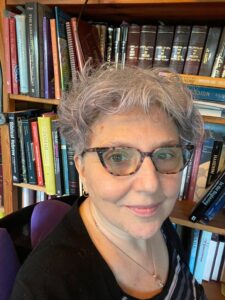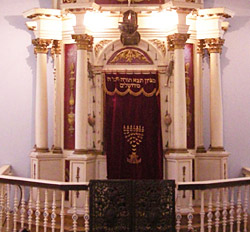
Moses had a revolutionary, revelatory experience while he was following his flock of sheep in Midian. The Torah, in Exodus 3:2 tell us:
:וירא מלאך יהוה אליו בלבת־אש מתוך הסנה וירא והנה הסנה בער באש והסנה איננו אכל
“An angel of Adonai appeared to him in a blazing fire out of a bush. He gazed, and there was a bush all aflame, yet the bush was not consumed.”
The burning bush that is not consumed sparked the movement for liberation from slavery that not only birthed our people, but continues to inspire liberation movements. It can inspire us, and give us guidance in how to take further steps in our own movements toward liberation in whatever forms we are called to.
So, what is the burning bush here to teach us?
The midrash[i] on Exodus 3:2 explains:
“From this they derived that the heavenly fire shoots out branches upwards, burns but does not consume, and is black in color; whereas fire used here below does not branch upwards and is red, and consumes but does not burn.”
It may be hard to imagine a black fire—perhaps it is counter-intuitive, or paradoxical. So what can we learn from this black fire?
The fire metaphor itself is multifold. It implies something awesome, powerful, something with the potential to give life or death. And then there is the concept of blackness, or darkness. When we see light, we see rays bouncing off of surfaces—we get the impression that the world is made up of separate, inherently bounded entities. But when we are in the dark, we are more easily able to sense that all boundaries are situational—we are able to feel beyond the limits of the self with a small S, and become aware of being part of a larger whole that includes all that is, and even all that is not. This may be why, a few verses after seeing the burning bush, Moses hid his face– In Exodus 3:6, the Torah says that “Moses hid his face because he was afraid to look at God. “
ויסתר משה פניו כי ירא מהביט אל־האלהים
This is usually interpreted in a negative way, that it is unfortunate that Moses wasn’t willing to see what would have been revealed to him had he not hidden his face.
But there is another way of looking at this—in hiding his face he avoided focusing on the sense of sight, which most often makes us think we are separate individuals, with boundaries that are revealed as light bounces off them. When you hide your face, you enter the realm where boundaries disappear, and it is easier to sense being part of a whole that is all that is, easier to sense how we are not separate from G-d, or from anything else.
Later in Exodus, when Moses goes up Mount Sinai to receive the Torah, we are told “Moses came near the thick darkness (arafel) where G-d was.” (Ex.20:18). The Kotsker Rebbe, Menachem Mendel, comments[ii] that the arafel, the thick darkness, is the ikkar, the essence, and the p’nimiyut, the innermost part, and that is why the divine presence was there. In order to receive Torah, Moses had to go into the essence, the innermost part, of reality, somewhere beyond our usual understandings. When the Torah says Moses hid his face, it uses the root satar—samech, tav resh. The same root is used when the Torah talks about G-d hiding G-d’s own face. But it is also the root used for the word shelter—seter. The Psalms often ask for us to be held in the divine shelter, or hiding place. [iii] So it seems to me that if we are hiding with the Holy One, we are in the dark together—in intimate proximity, able to feel the interconnectedness of all.
So, perhaps too, in seeing the black fire of the bush, Moses was brought into a realm beyond the usual boundaries. He was empowered to move beyond what he thought possible, and he was given the means to do it, through the ability to connect with a power beyond his individual self.
This is in keeping with another image of black fire which comes from a teaching brought in Talmud and Midrash:[iv]
The Talmudic form of the teaching says the following:
“Rabbi Pinchas [said] in the name of Rabbi Shimon ben Lakish: the Torah that the Holy Blessed One gave, its hide is white fire, its ink is black fire; it is fire mixed with fire, carved from fire, and given from fire: “at His right hand a ritual of fire for them”.(Deuteronomy 33)”
If you have ever looked at the script of the Torah scroll, it is easy to imagine that it is written in black fire—the shape and flourishes of the letters are very reminiscent of flames, and not coincidentally. But the midrashic telling of the same teaching has an additional phrase at the beginning. It says:
“Rabbi Yochanan said: One who engages in Torah should see oneself as if he were standing in fire.” That is, we are not to experience the sacred fire of Torah just from the outside—we are meant to experience it from the inside. We are meant to be immersed in it. There is another teaching, that each Israelite is a letter of the Torah. If we look at these teachings together, we see that each of us is invited to experience ourselves as a letter of Torah, a letter made of black fire.
Medieval kabbalist Rabbi Isaac the Blind calls the black fire of Torah “the world to come”, and associates it with the Oral Torah—that is Talmud and midrash.[v] He explains that “It is the hue of a black fire on white fire, which is the Written Torah. Now the forms of the letters are not vowelized nor are they shaped except through the power of black, which is like ink. So too the Written Torah is unformed in a physical image, except through the power of the Oral Torah.” He also calls the black fire the “crown of the kingdom”, keter malchut. This is an interesting concept—keter, or crown, is the highest or most transcendent, sefirah, or sphere of reality, in the kabbalistic tree of life, while malchut, or kingdom, is the lowest, or most manifest.
Yet in this royal imagery, the crown sits right on the head of the king. So the whole system has a different topology from what we usually think of—it is not a linear hierarchic system, but rather circles back on itself.
Rabbi Isaac explains this concept with another image of black fire—the burning coal, in his commentary on the ancient text, Sefer Yetzirah.
Sefer Yetzirah says “Ten sefirot of Nothingness. Their end is embedded in their beginning and their beginning in their end, like a flame in a burning coal. For the Master is singular; He has no second, and before One, what do you count?” Rabbi Isaac the Blind explains this verse by saying:
“Their end is (found) in their beginning: just as many threads come out of the burning coal, which is one, since the flame cannot stand by itself, but only by means of one thing; for all [the] things [(that is, Sefirot)] and all [the] attributes, which seem as if they are separate, are not separate (at all) since all (of them) are one, as their beginning is, which unites everything in one word.”[vi]
The burning coal, then, reminds us of that from which all else emanates. “Their end is embedded in their beginning” explains what R. Isaac said in his previous text, that the black fire is the crown of the kingdom; that is, the ultimate source, which one might think is furthest from the manifest world, is actually closest to it. And all of it is rooted in that black coal, without which the flames that emanate could not exist.
Our source is in the darkness. Without it we do not exist. And although that darkness is the most transcendent we can imagine, it is also closer to us than anything else ever could be. It is our innermost being. And that dark source is where we go to experience the sacred, where we go both when we want to feel safe, and when we are challenged to go beyond the beyond—the innermost, the deepest, the furthest, the closest.
So, I invite all of us to take sometime in contemplation, whether by hiding our faces, closing our eyes to see deep within ourselves, or by seeking the black fire we are immersed in, the black fire of Torah, or the fire beyond our usual limits—the black fire of the burning bush. Whatever form of the sacred dark calls to you—take some time to be with it, or to be in it, to open to its call to go deeper, or further, to find where, or how, we might be led to answer the call for liberation.
Exodus Rabbah 2:5
[ii] In Emet V’Emunah (quoted in P’ninei haTorah)
[iii] The connection between the hiding of G-d’s face and the divine shelter in the book of Psalms is discussed in Herbert Levine’s book, Sing Unto G-d a New Song, Indiana University Press, 1995
[iv] Yalkut Shimoni, Brachah, 951 and Talmud Yerushalmi Sotah 37a
[v] Unpublished manuscript, “The Mystical Torah—Kabbalistic Creation”, translated by Ronald Keiner in Joseph Dan’s book, The Early Kabbalah
[vi] Quoted in Gottlieb, Freema. The Lamp of G-d: A Jewish Book of Light. (Jason Aronson, Northvale NJ, 1989)
This paper is a slightly edited version of a talk given at Kehillah Community Synagogue, Dec 21, 2013, as part of a weekend workshop I taught on the Sacred Dark. It was published in Tikkun on December 29, 2015 http://www.tikkun.org/nextgen/the-burning-bush-and-black-fire


